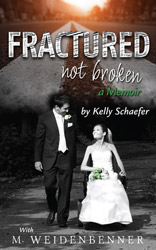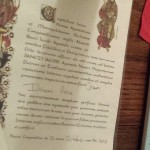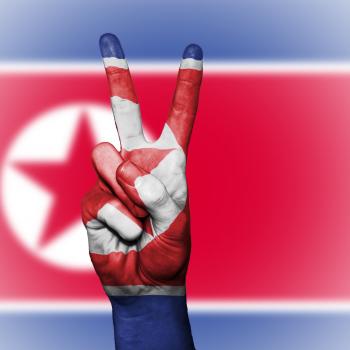 Kelly Schaefer’s memoir, Fractured, Not Broken, erases the boundaries of religious doctrine and gets right to the heart of why we pray. I read it recently as part of the Patheos.com Book Club, and I trust it will stay with me thanks to its universal themes of faith, love and healing.
Kelly Schaefer’s memoir, Fractured, Not Broken, erases the boundaries of religious doctrine and gets right to the heart of why we pray. I read it recently as part of the Patheos.com Book Club, and I trust it will stay with me thanks to its universal themes of faith, love and healing.
Written with the help of Kelly’s aunt, M. Weidenbenner, the book recounts the night in 1999 when a car in which Kelly was riding was hit head-on by a drunk driver, leaving her a quadriplegic.
Until the accident, Kelly had been an active college student and cheerleader, which made the prospect of life in a wheelchair all the more devastating. But that’s just the beginning of the story.
The book traces Kelly’s progress after the accident, documenting the remarkable faith and tenacity she showed in becoming an elementary school teacher, wife and mother.
It’s a story that certainly inspires, but it also gives comfort, reminding us that things do work together for good, even when circumstances seem to prove otherwise.
Here are a few of the reasons I highly recommend this book.
It takes us into Kelly’s world. There are many excellent books written by people who have faced extreme challenges and loss. But I consider this one of the best because it’s so achingly honest. It’s easy to walk past people in wheelchairs without a thought to their daily routine, but Kelly describes what it really means to be confined in your own body.
What do you do in the middle of the night when you can’t turn over or sit up to cough? How do you deal with someone catheterizing you every four hours to collect your urine? Where do you find the trust to do something as adventuresome as tubing, knowing that if you flip into the water, you’ll have to count on someone to save your life? What does it take to surrender your body to the care of others when you were once able to do back flips and cartwheels without a thought?
This isn’t a world most of us want to even consider, but Kelly’s willingness to share such intimate details makes us more sensitive to a life that’s easy to misunderstand or ignore.
It reminds us that there’s a place for both acceptance and perseverance. At first, Kelly resists the idea that she’ll never walk again, believing that she can will her body to heal. But she eventually sees that denying her situation isn’t giving her strength—in fact, it’s keeping her stuck. Only when she accepts her condition does she sees the possibilities within it—a shift that leads her back to college to become an elementary school teacher, along with other notable accomplishments.
It shows the hand of God at work. I marveled at many things in this book, but one of the most powerful was seeing the hand of the Divine bring Kelly and her husband Shawn together over a period of years. The story shifts back and forth between their two lives, documenting the many times Shawn tried and failed to find Kelly, who he had seen in an ESPN interview after the accident.
Their parallel stories show how—gradually and through a power greater than their own—they eventually came together. It happened just as Kelly prayed for someone to share her life with. Because the book lets us in on the events leading up to that prayer, we can see how Kelly’s request throws the door open to a relationship that was already in the making.
It’s a powerful reminder that our prayers sometimes are simply saying “Yes” to the good that Spirit has already set in motion for us—and that some prayers take time to answer, allowing for seeds to take hold before they sprout.
It shows that we can’t judge life events as good or bad. Years before Shawn met Kelly, he was changed by the loss of his sister’s fiancé, who died of cancer in his twenties.
That experience opened Shawn’s heart and made him more aware of what he valued in life—a shift that eventually led him to Kelly.
If Kelly hadn’t been struck by the drunk driver, she and Shawn probably wouldn’t be married today, nor would they be the parents of two children from the Congo.
And their story wouldn’t be inspiring countless others to have faith even when their lives seem fractured.
So who’s to say? Good or bad? Gift or tragedy?
We could debate these kinds of questions, just as we could debate religious theology and doctrine. But to me, one of the most important lessons of this book is that it strips faith down to its essence, our personal relationship with the Divine.
In the dark of night, when you’re facing overwhelming challenges, you want to know that there’s a power that listens and is working on your behalf, weaving its mysterious and miraculous threads of goodness in ways that we can’t fully understand.
Kelly shows what’s possible when we trust in that power and have patience. And she also is clear about how difficult that can be. At the end of the book, she writes:
“Many people think that I play the part God picked for me really well. Most days that’s true, while other days I am merely a great actress hiding my feelings. The truth is…I still mourn for the old me every day.”
Fully human, fully spiritual. Kelly shows us what that means without sugarcoating or sentimentalizing it. In the end, she makes her personal story a universal one, reminding us what’s possible when we let our faith lead the way.












